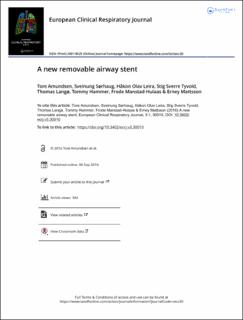| dc.contributor.author | Amundsen, Tore | |
| dc.contributor.author | Sørhaug, Sveinung | |
| dc.contributor.author | Leira, Håkon Olav | |
| dc.contributor.author | Tyvold, Stig Sverre | |
| dc.contributor.author | Langø, Thomas | |
| dc.contributor.author | Hammer, Tommy Arild | |
| dc.contributor.author | Manstad-Hulaas, Frode | |
| dc.contributor.author | Mattsson, Erney | |
| dc.date.accessioned | 2020-06-09T06:33:25Z | |
| dc.date.available | 2020-06-09T06:33:25Z | |
| dc.date.created | 2016-11-12T11:58:29Z | |
| dc.date.issued | 2016 | |
| dc.identifier.issn | 2001-8525 | |
| dc.identifier.uri | https://hdl.handle.net/11250/2657257 | |
| dc.description.abstract | Background Malignant airway obstruction is a feared complication and will most probably occur more frequently in the future because of increasing cancer incidence and increased life expectancy in cancer patients. Minimal invasive treatment using airway stents represents a meaningful and life-saving palliation. We present a new removable airway stent for improved individualised treatment. Methods To our knowledge, the new airway stent is the world's first knitted and uncovered self-expanding metal stent, which can unravel and be completely removed. In an in vivo model using two anaesthetised and spontaneously breathing pigs, we deployed and subsequently removed the stents by unravelling the device. The procedures were executed by flexible bronchoscopy in an acute and a chronic setting – a ‘proof-of-principle’ study. Results The new stent was easily and accurately deployed in the central airways, and it remained fixed in its original position. It was easy to unravel and completely remove from the airways without clinically significant complications. During the presence of the stent in the chronic study, granulation tissue was induced. This tissue disappeared spontaneously with the removal. Conclusions The new removable stent functioned according to its purpose and unravelled easily, and it was completely removed without significant technical or medical complications. Induced granulation tissue disappeared spontaneously. Further studies on animals and humans are needed to define its optimal indications and future use. | en_US |
| dc.language.iso | eng | en_US |
| dc.publisher | Taylor & Francis Open | en_US |
| dc.relation.uri | http://www.tandfonline.com/doi/pdf/10.3402/ecrj.v3.30010?needAccess=true | |
| dc.rights | Navngivelse 4.0 Internasjonal | * |
| dc.rights.uri | http://creativecommons.org/licenses/by/4.0/deed.no | * |
| dc.title | A new removable airway stent | en_US |
| dc.type | Peer reviewed | en_US |
| dc.type | Journal article | en_US |
| dc.description.version | publishedVersion | en_US |
| dc.source.volume | 3 | en_US |
| dc.source.journal | European Clinical Respiratory Journal | en_US |
| dc.source.issue | 1 | en_US |
| dc.identifier.doi | 10.3402/ecrj.v3.30010 | |
| dc.identifier.cristin | 1399749 | |
| dc.description.localcode | #2016 Tore Amundsen et al. This is an Open Access article distributed under the terms of the Creative Commons Attribution4.0 International License (http://creativecommons.org/licenses/by/4.0/), allowing third parties to copy and redistribute the material in any medium or format and to remix,transform, and build upon the material for any purpose, even commercially, provided the original work is properly cited and states its license | en_US |
| cristin.ispublished | true | |
| cristin.fulltext | original | |
| cristin.qualitycode | 1 | |

